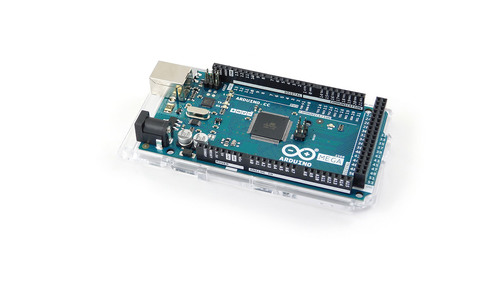Recently added
More...Categories
Suppliers
Newsletter
Once, twice in month we will send You info about new products, products on sale and news from Arduino and DIY world.
Arduino Mega 2560 Rev3

Arduino reference version - will serve you for a long time! More memory, more inputs - meet Arduino Mega
What is Arduino Mega?
Arduino Mega 2560 is a developer board based on ATmega2560 microcontroller.
Arduino Mega 2560 is compatible with Arduino Duemilanove/UNO footprint. It means, the shields designed for Duemilanove will also fit to Mega board. However, there are some differences between functions of particular pins, thus not every shield can be used with Arduino Mega. One could say, Arduino Mega is Arduino UNO's older brother - bigger memory, more input/output pins, so it's dedicated to more advanced applications than UNO.
Totally it has 54 digital inputs/outputs (including 14 capable of PWM operation), 16 analog inputs, 4 serial ports (UART), SPI and I2C interfaces. Available memory is 256 KB of flash, 8 KB RAM and 4 KB EEPROM. The processor works with frequency of 16 MHz.
This model is also equipped with new USB chip (so as Arduino UNO) - ATmega16U2 (instead of ATmega8U2 or FTDI chips used previously).
What it means for the user? Additional 3.3V voltage regulator provides 150 mA of overall maximum output current (compare it to 50 mA offered by previous versions). What's more, ATmega16U2 has its own firmware, which can be reprogrammed when necessary. Thanks to this, Arduino can appear as different type of hardware (mass storage device, keyboard or another HID device) when connected to PC.
Arduino Mega 2560 boards sold by us are original. Buying it, you're supporting the Arduino team (a part of the revenue is committed for further Arduino development).
The board is simple to use, in accordance to Arduino project's philosophy - connect it to PC with USB cable and you are able to begin programming in a free development environment, available for Windows, Linux and Mac OS X operating systems (in every of them it requires Java to work). Advanced users can use another IDE environments (toolchain avr-gcc).
Thanks to pre-loaded bootloader, you don't need additional programmer. Your program is loaded through USB.
R3 - reference version
Arduino Team announced that Arduino Mega 2560 R3 (R3 stands for Revision 3) is reference model.
What it means?
Arduino is a live project, constantly evolving. Both the hardware and the software (the IDE itself as well as Arduino library) was changing in the past time. When R3 and IDE v. 1.0 were released, the Arduino team announced that since then Arduino and the IDE will be further developed, but the Mega R3 and IDE version 1.0 will be reference for future releases.
For an ordinary user, it doesn't matter much, but in case you want to, for example, conduct a workshop which will be periodically repeated, or you to use Arduino in your school, then basing on R3 and version 1.0 should keep everything up-to-date for a long time.
Changes in R3
The differences between Arduino Mega 2560 R3 and R2 are:
- In each row of pins there is two more now. In "digital section" there are two pin header sockets: 10 and 8 pins, instead of 2 x 8. In "analog section" there are now 8 and 6 pins instead of 2 x 6.
- ATmega8U chip responsible for USB communication were replaced by ATmega16U (16 kB of flash memory instead of 8) - this involves only advanced users, who want to change the type of hardware, as which Arduino appears, when connected to PC (e.g. keyboard instead of serial port)
Adding new pins causes some confusion. In digital pins row there are now two separate I2C (or TWI, according to Atmel's documentation) bus signals - SDA and SCL. These aren't additional signals - in Arduino UNO R2 SDA and SCL are available at A5 and A4. In R3 they are also there, so the new pins are merged with old ones.
In analog section among new pins there is IOREF signal informing, at which voltage levels the board works. This allows shields to adapt to Arduino's voltage level. The second pin is not yet connected. It's reserved for future use.
What is this for?
SDA and SCL are available at the same pins in Arduino UNO and Mega, IOREF is 5V in every case, so what are the new pins for? Things may change when new Arduino models, Due and Leonardo, will be introduced. These models may not have SDA and SCL at A4 and A5 and operate at supply voltage 3.3V.
Thanks to the new pins, shields using I2C and designed to use SDA and SCL at the new pins will also work with Arduino Mega R3 as well as future Arduino versions. IOREF in turn will allow a single shield to work with both Arduino Mega R3 and future versions employing 3.3V logic.
Simply speaking - Arduino Mega R3 ensures you will be able to use new shields for a long time.
Recently added
More...Categories
Suppliers
Newsletter
Once, twice in month we will send You info about new products, products on sale and news from Arduino and DIY world.















